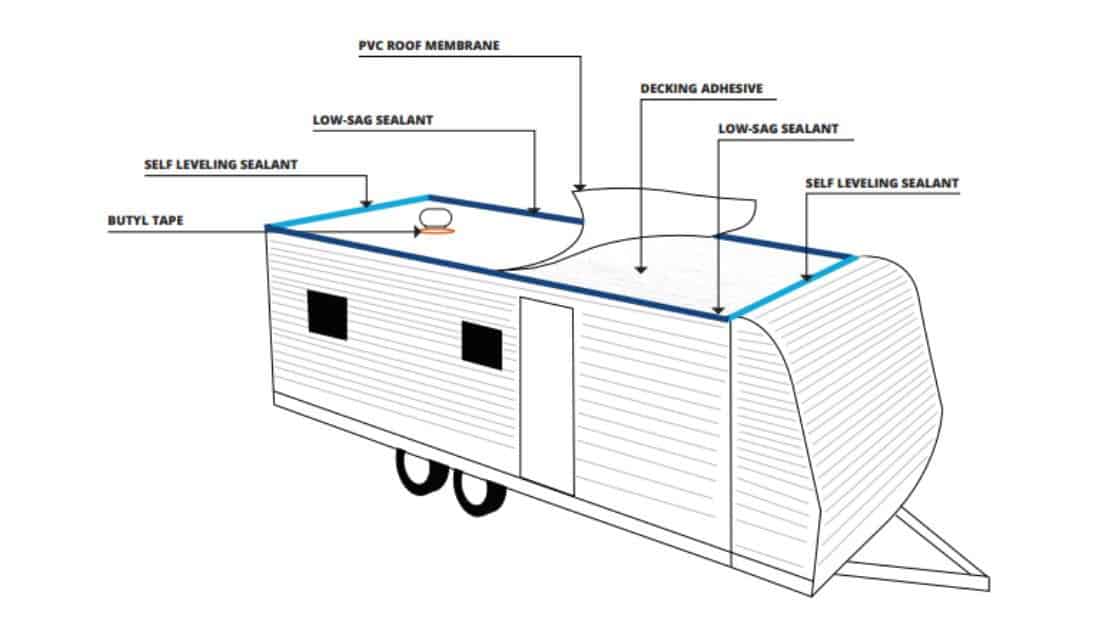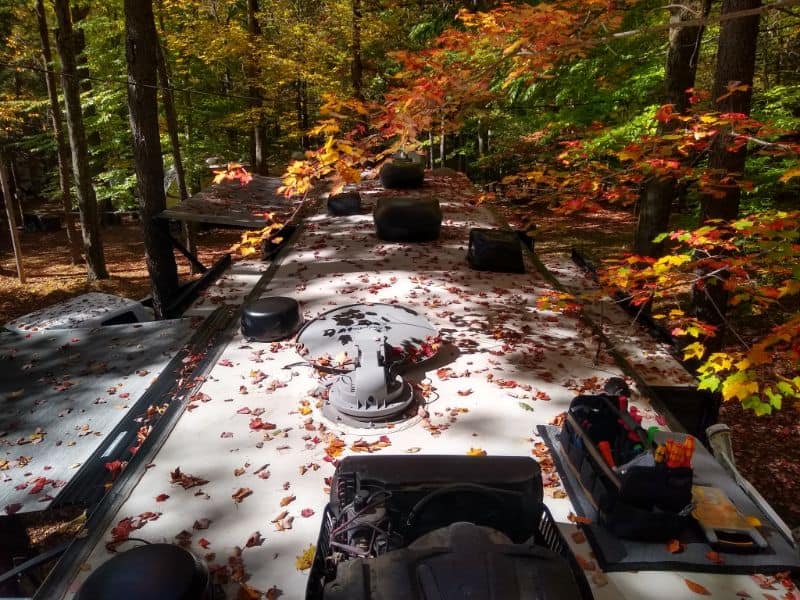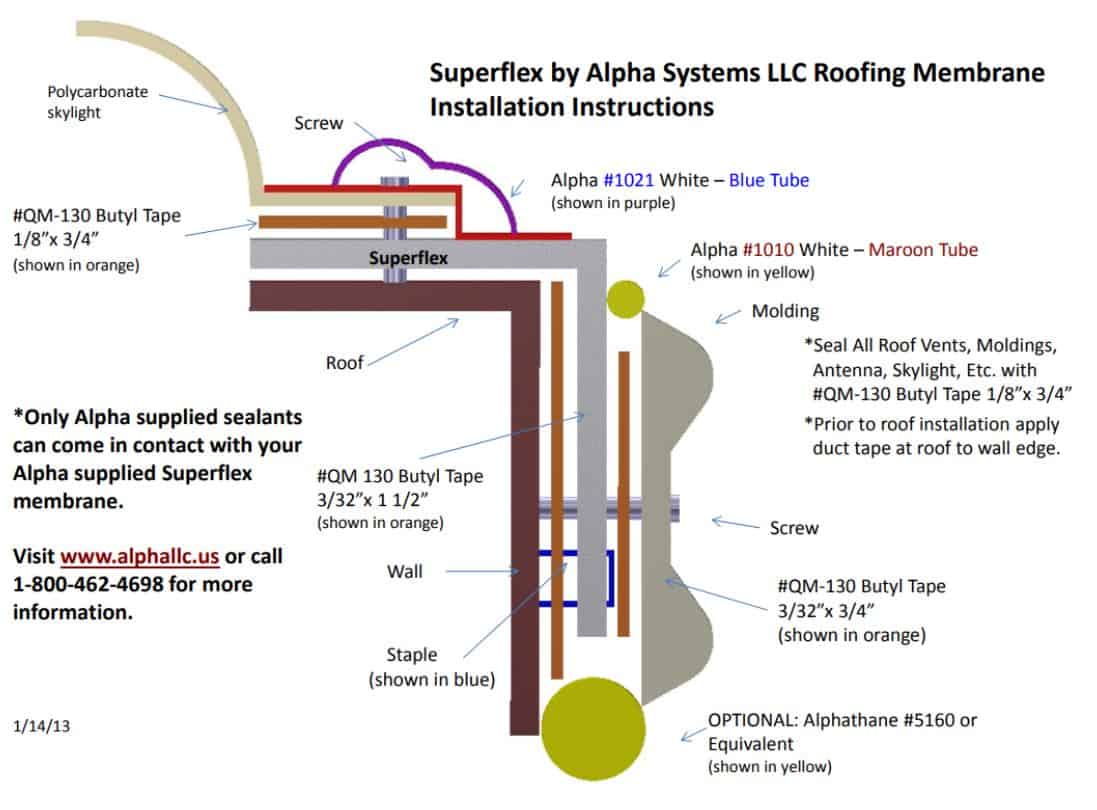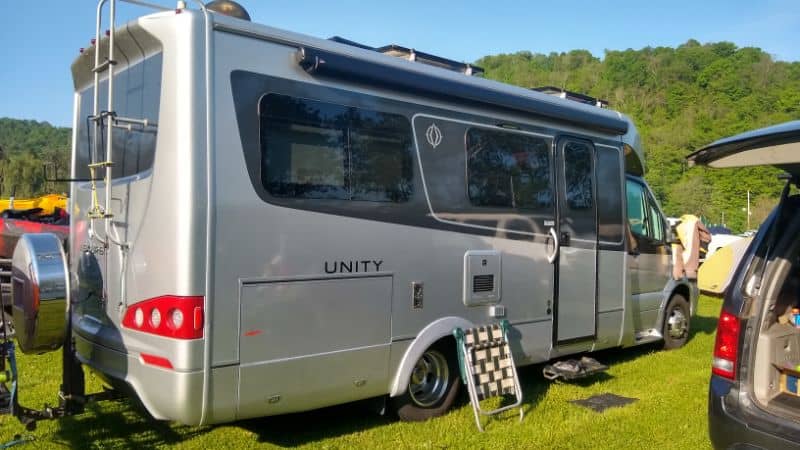When it comes to an RV roof, “No news is good news.”
So if you’re reading this guide, it’s probably because there’s something wrong with your roof. I’m sorry about that. If it helps, you can read my guide to sealing your RV roof or common causes for RV roof leaks.
Or you might be reading this guide because you’re a responsible RV owner who wants to properly maintain their investment (good for you!). I’m glad you’re here. Because you don’t want to use aluminum polish on a rubber roof! You’ll only make that mistake once.
Or you might be here because you’re a smart, educated customer, and you’re trying to become just a little bit smarter before buying. I applaud that. A well-maintained camper or motorhome roof can be the difference between a junker and a collectible.
Here are the six types of roofs you’re likely to find on your RV motorhome, camper or trailer.
1. EPDM

There’s a 3 out of 4 chance that your RV has an EPDM roof. It was the standard for many decades.
If you enjoy Trivial Pursuit, you’ll want to know that EPDM stands for Ethylene Propylene Diene Monomer. Otherwise, this information is useless, and no one else cares.
EPDM is a rubbery sheet membrane. It’s flexible and slightly stretchy. It has excellent resistance to most chemicals and UV radiation. The estimated lifespan is 15-30 years, although RV EPDM roofs have been known to fail in less than 10.
It’s not just used on RVs. EPDM has been the de facto standard for flat commercial roofs for decades. Your local Walmart probably has an EPDM roof. So does your neighbor’s koi fish pond.
However, there are several differences.
- EPDM for RVs is dyed white, not black, for better solar reflectivity.
- Most RVs use 27-45 mil thickness, which is considered the thinnest commercially viable thickness for roofing applications. Yup, it’s cheap.
- Most camper EPDM membranes are double-ply. White is more expensive than black, so OEMs like Dicor will laminate two layers – one black, one white – for the total thickness. If the upper layer wears off, you’ll have nothing but a black roof!
- Some membranes, like Dicor’s BriteTEK, have a fleece or woven backing for enhanced adhesion to the underlayment roof decking.
How Is It Installed?
EPDM is glued onto a plywood roof deck in a single sheet. (Imagine applying plastic Saran wrap to a Tupperware container).
You might have one or two seams on your roof. These are called “lap seams” and each OEM has very specific instructions on how your RV manufacturer is supposed to seal these seams. Even better is no seams at all!
Maintaining an EPDM Roof
EPDM should be treated and reconditioned every 6-12 months. Avoid anything with petroleum distillates or citrus cleaners.
Be careful walking around, though! EPDM is very slippery when wet.
Minor punctures or abrasions can be repaired with an adhesive shingle or liquid-applied EPDM. You can even use EternaBond.
Advantages of an EPDM Roof
- Lightweight
- Affordable
- Often seamless
Disadvantages of an EPDM Roof
- Chalking on the sidewalls of your RV (especially if you don’t have gutter rails).
- Must be regularly conditioned.
- The upper layer can wear off, exposing the black lower layer.
- Can be somewhat easily punctured or poked.
- Absorbs quite a lot of heat.
- If severely torn or disintegrated, the entire roof membrane must be replaced.
- Not cheap!
2. PVC
To the untrained eye, PVC doesn’t look much different than EPDM. It’s a white, flexible plastic membrane that stretches over your RV decking. What’s the big difference?
PVC roofing was developed to fix some niggles common to EPDM roofing.
- PVC roofing doesn’t chalk or streak.
- PVC roofing doesn’t require treatments or coverings.
- PVC roofing has greater resistance to punctures and tears.
- PVC roofing is naturally mold- and mildew-resistant.
- PVC roofing is naturally white and super-reflective, keeping your RV cooler.
Think of PVC as an improved EDPM. It’s arguably the best of the three common membranes. You get what you pay for, though. It’s usually the most expensive on a per-square-foot basis.
The most popular PVC roofing for RVs is Lasalle Bristol’s XTRM Ply. With proper maintenance, you can expect a PVC membrane to last for 20-30 years, although most Defects warranties are for 15 years.
How Is It Installed?
For the most part, installing PVC is similar to EPDM. You don’t have to stretch the membrane to eliminate wrinkles, though.
I stole this graphic from LaSalle Bristol, the exclusive distributor for XTRM Ply PVC roofing.

PVC is a true single-ply membrane. It has a 100% wear layer, top to bottom. Manufacturers like PVC because it can be solvent-welded or heat-welded, whereas EPDM cannot be heat-welded.
Maintaining a PVC Roof
PVC roofing doesn’t require reconditioning. However, it should still be regularly swept and washed with clean, soapy water. Dicor recommends caring for your Tufflex PVC roof at least 4 times annually.
Patches and lap seams can be made with a PVC vinyl contact adhesive.
Advantages of a PVC Roof
- Does not chalk or streak.
- Does not require reconditioning maintenance.
- Puncture- and tear-resistant.
- Naturally mildew-resistant.
- Excellent solar reflectivity.
Disadvantages of a PVC RV Roof
- Not as flexible as EPDM (for compound curved roofs).
- More expensive than EPDM.
3. TPO

So, TPO roofs initially got a bad rap. OEMs said they’d invented something as good as EPDM at a lower cost. Fast forward a few hundred warranty claims, and they realized that wasn’t true.
But chemical companies have been tweaking the formulas since the 1980s, and today, TPO has come a long, long way!
The main name in the RV industry is Alpha Systems SuperFlex, followed by Dicor DiFlex II.
TPO is slowly becoming the new favorite RV roofing material. It doesn’t chalk or fade. It’s incredibly lightweight. It doesn’t tear or puncture easily. And unlike PVC, it’s easy to stretch and conform to curved surfaces.
How Is It Installed?
Same way as EPDM! (Another reason RV manufacturers like this stuff). I’ll let Alpha Systems show you exactly how they recommend installing their Superflex product:

How Is It Maintained?
Maintaining a TPO roof is very similar to EPDM. However, you don’t need to regularly apply UV protectants and conditioners. Here’s what Alpha Systems says:
The Alpha roof membrane is quite inert and will resist weathering well; nor does it require the periodic application of products to protect it from ultra-violet light or ozone. In fact, these products can often cause damage to the roof membrane.
-Alpha Systems
Advantages of a TPO Roof
- Lightweight! Approximately half the weight of EPDM.
- Less chalking and streaking.
- Best for roofs with complex-compound curves.
- Better traction thanks to orange peel texture
Disadvantages of a TPO Roof
- Very stretchy! Can wrinkle or bunch over time.Limited lifespan compared to PVC roofing (10-20 years)
- Requires regular maintenance and conditioning.
4. Gel-Coated Fiberglass

Readers, I gotta tell ya … there’s an incredible amount of flat-out wrong and dumb information out there about fiberglass RV roofs. I read one website that said:
“A fiberglass roof, quite simply, is a roof made out of fiberglass. The base mat is woven fiberglass. If it is a shingle roof, expect waterproof asphalt coating and ceramic granules for ornamentation and insulation.”
Almost every single word in that sentence is wrong (I actually think a robot wrote it.) So, from a human, here’s the real deal!
Think of a fiberglass RV roof as a 3-part sandwich:
- Substrate: This is the backing that the fiberglass itself is glued to. Fiberglass sheet itself is floppy and flimsy, and it would destroy itself on a roof. The backing substrate adds rigidity and strength. Generally, this is luan plywood or 2.7 or 3.5mm Azdel.
- Fiberglass: This is the middle layer. It’s a resin matrix with embedded glass fibers (chopped or woven, depending on quality).
- Gel coat: Raw fiberglass is A) ugly and B) breaks down in sunlight. So the finished product gets a gelcoat, which is a protective layer of clear or pigmented UV-safe polymer resin. If you ever see spider web cracking on your fiberglass roof, for instance, it’s likely just the gelcoat that’s cracked; the base fiberglass is probably OK.
Gel-coated fiberglass roofs are found on premium campers. They aren’t cheap. They have two big advantages:
- Maximum durability. A fiberglass skin is sturdy, durable, doesn’t chalk, and doesn’t easily puncture. It’s the same fiberglass as your RV wall, so you’re guaranteed similar performance. It can handle tree branches and hail that would dismember a membrane roof.
- Looks great. Fiberglass can be made in just about any color. It has a semi-gloss sheen. So long as the gelcoat doesn’t crack, it’ll keep its looks for decades.
How Is It Installed?
A fiberglass RV roof is “floating.” That means it’s not glued down; it’s just held down at the ends, edges, and penetrations.
A fiberglass roof is sometimes called a roof “skin.” These are large, rectangular sheets of seamless fiberglass sheet. Openings must be routed, not cut.
How Is It Maintained?
A fiberglass sheet just needs to be thoroughly and periodically cleaned. It doesn’t need any protectants, conditioners, or coatings. It’s hardly affected by most chemicals, tree sap, or bird droppings, all of which can stain or damage common membranes.
You might want to apply a wax or fiberglass protectant. Otherwise, the gelcoat can slowly oxidize over time.
Unlike a membrane roof, fiberglass can be cleaned with a scrub brush or even a pressure washer (not that I recommend a pressure washer; it can damage caulks and seals).
Advantages of a Fiberglass Roof
- Never chalks or streaks!
- Easily cleaned and maintained.
- Walkable and durable.
Disadvantages of a Fiberglass Roof
- Heavy, heavy!
- Cracking is very expensive to repair.
- Cannot be easily re-coated or overlaid.
- Large repairs require replacement.
- Slippery when wet.
5. Aluminum

When I say “aluminum roof,” you’re probably thinking of an Airstream. And you’d be right! Airstream uses aircraft-grade 2024T3 alclad aluminum on the roof, sometimes painted with a white enamel.
Airstream and Bowlus are the only two manufacturers I know of that use riveted aluminum roofs in monocoque construction
However, other manufacturers also use aluminum roofing. But theirs is simple coil aluminum (just imagine aluminum foil x 1,000,000). You’ll find coil aluminum on many teardrop-style trailers and cargo trailers.
Aluminum has the big advantage that while it can dent, it doesn’t easily break. With some effort, dented aluminum can be Bondo’d and re-painted. The material itself will outlive you, not just your RV!
Coil aluminum is standard fare for tractor trailers, where it is sold in 102” widths.
Aluminum can be sold bare or finished.
- Mill finish (bare) aluminum can be polished to any desired sheen, but it will chalk without regular maintenance.
- Anodized aluminum is electrically coated in an acid bath. But if/when the anodic layer begins cracking, there’s no fixing it …
- Painted aluminum can be finished with a baked enamel finish. They’re commonly available as 4×8 and 5×10 sheets.
- Formed aluminum is often finished with a Kynar fluorocarbon finish, which can be bent or stamped without cracking. Not something you normally see on an RV roof.
How Is It Installed?
“Floating” aluminum coil roofs are installed much like floating fiberglass roofs. Aluminum is usually NOT glued to the sheathing underlayment. Instead, it is loose-laid (also known as floating) and then mechanically secured around the edge and cut-outs.
Seams in coil aluminum are normally mechanically joined through riveting, clinching or some other method, since welding thin-gauge aluminum requires a great deal of operator skill. In my observation, aluminum is usually riveted or installed seamlessly.
Riveted aluminum roofs, such as on an Airstream, are installed in a completely different manner (way beyond the scope of this article!)
How Is It Maintained?
Maintaining an Airstream is an art form in itself. Good luck sealing all those rivets. And the polishing … my God, the polishing …
But maintaining a coil aluminum roof is pretty simple. Just make sure to use cleaners and protectants approved for your type of aluminum (bare, anodized, painted, etc.)
Advantages of an Aluminum Roof
- Will outlive you!
- Looks vintage/retro.
- Available in dozens of finishes and colors.
Disadvantages of an Aluminum RV Roof
- Chalks something awful! Must be periodically waxed and polished.
- Dents must be professionally repaired.
- Dents from large hail or trail limbs.
- Quite heavy and cumbersome.
- Transfers lots of heat.
6. Stamped Sheet Metal

If you’re the proud owner of a Class B Van, then you’re lucky enough to have an automotive-style roof! In other words: Sheet metal, usually zinc-coated stamped steel.
You’ll find this type of construction in conversion vans built on the Mercedes Sprinter, Ford Transit, Ram Promaster, and Chevrolet Express van cab chassis.
(If your upfitter installed a pop-up roof, all bets are off.)
There’s not much to be said about this construction method. Auto manufacturers are sheet metal magicians. It’s the same roof used in commercial vans, which endure for decades.
How Is It Installed?
Class Bs are unique in that an automotive manufacturer fabricates the cab, chassis, and “house,” the body of the RV. So the RV manufacturer itself doesn’t install anything. At most, they’ll cut holes in the roof for pop-ups, vents, roof-top tents, etc.
How Is It Maintained?
An automotive-style roof should be kept clean, same as your car roof. Wax or protect the painted finish annually. Other than that, maintenance is minimal.
Don’t just ignore your roof 11.9 months out of the year, though! You still need to maintain your roof sealants, which likely won’t last as long as your paint finish.
Advantages of a Sheet Metal Roof
- Best-in-class durability.
- Super easy to clean.
- Resistant to chemicals, environment, UV.
- Usually walkable.
Disadvantages of a Sheet Metal Roof
- Repairs require professional expertise and equipment.
- … That’s all I can think of!
Leave a Reply